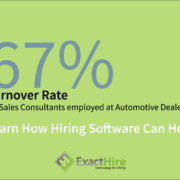Data Privacy and Employee Surveillance
Remote work presents a litany of challenges for an organization. One of those being how the organization handles data privacy. Another is the unique challenges of remote hiring. To circumvent these issues utilize ExactHire’s Full Service Hiring service. We will send out job advertisements, source candidates, interview candidates, and finally present to you the final best options for the position for you to make your hiring decision.
Data Privacy
Privacy is a concept that is hard to find and fleeting to define in our evolving world. The average employee will spend over 90,000 hours at work over their lifetime. We are constantly connected through devices. People’s professional and personal lives blend in many roles. Particularly for salary employees who often respond to work needs at all hours of the day. The pandemic rapidly shifted many employees to fully remote or hybrid roles where work has been successfully completed outside the company workspace.
Many remote and hybrid employees are enjoying their new office environment in the comforts of their home or while traveling. With the dramatic shift in work environments, that has led to some companies developing heightened concerns about their employees’ actions and efficiency. Companies are in the midst of conundrum on how to validate that employees, both onsite and remote, are ethical and using work time to perform work specific tasks while recognizing that employees are humans who have to balance work with personal life and seek work autonomy.
Reasons For Monitoring Data
Companies express that they have bona fide reasons to monitor onsite and remote employees. Many jobs require the use of social media platforms. However managers want to know that their employees are performing their tasks and not scrolling social media for non-work related reasons. They want to know that employees are not sharing confidential information with unauthorized people. Also, concerns of workplace harassment and violence fuel managers’ concern to identify potentially volatile situations. Content from data monitoring can also be used in legal proceedings. The argument exists that employee surveillance is a way to mitigate risk. It can, but potentially at a cost.
How to Monitor Employee Data
Employee surveillance can occur in a multitude of ways. The most commonly known example is video recording within the public spaces of the work environment. Laws exist to prevent the use of cameras in private places, such as restrooms and locker rooms. State laws vary to the definition of locations and scope of camera use. With the increase of remote work, monitoring software can be downloaded onto electronic devices to monitor employees’ activities on their laptops and phones. Device GPS features can identify where an employee is located as well.
Reasons For and Against Data Privacy
While employee surveillance can potentially mitigate risk and loss of productivity and profit, it can also be a catalyst for a loss of productivity and profit. Employees have bona fide reasons to dislike employee surveillance. Keystroke and website monitoring software will track employees’ actions within their devices. Time management software can calculate active and idle time, but what defines active and idle? Maybe that employee who is listed as “idle” is having a phone conversation with a customer or coworker. That person could be reviewing a book or other non-electronic resource for a work task.
Many employees feel that they are not trusted to do the tasks of the role in which they were hired when monitoring controls are implemented. If employees complete a task too quickly, then they can be questioned about what they do in their downtime. If they take too long to complete a task, the employees’ abilities could be questioned. It is inevitable for an employee at any level not to have a need to address a personal matter during the day. Will that employee be penalized if they take a moment to order a birthday gift online or schedule an appointment? The possibility exists especially if a company does not have a clearly defined policy itemizing expectations and purposes of employee data monitoring.
Federal Laws for Monitoring Data
Before crafting or amending a company policy on employee data privacy and surveillance, it is important to be aware of federal and state legislation regarding these concepts. The Electronic Communications Privacy Act of 1986 (ECPA) is a federal law that specifically addresses monitoring of electronic communications in the workplace. Within this legislation, the “business purpose exception” allows employers to monitor oral and electronic communications provided the company can validate a legitimate business purpose for doing so.
This legislation establishes minimum restrictions. Keep in mind that states can create more restrictive legislation. So if your organization hires in different states or countries, it is essential to know the established laws for those areas. Unionized companies in particular must be cognizant that workplace recording typically is agreed upon in collective bargaining discussions before monitoring is implemented. If monitoring occurs without being approved by union stewards, the company could face repercussions. ExactHire does not provide legal counsel. So consult with your company’s legal team regarding data privacy and employment surveillance policies or plans for your organization.
Honesty in the Workplace
Honesty is the best policy. So is having a data privacy and employee surveillance policy which is communicated and understood by all employees. Companies need to be forthcoming with their employees so employees understand what information is being collected and why. Employers need to create a data privacy and employee surveillance policy for employees that outlines key items. These include what is being monitored and when, what is prohibited use, what will happen if violations occur, how will employees’ data be used and stored for starting points.
Include company specific needs in the policy also. Solicit feedback from management and employees to understand differing perspectives. Once a policy is created internally, the company’s legal team should examine the content. Ensure it adheres to all federal, state, and applicable international laws. All employees should be informed about the data privacy and employee surveillance policy in a consistent way and educated on the company’s expectations and repercussions as outlined in the policy. Employees should be given ample opportunities to ask questions and seek clarification of the final policy before signing. Whether the policy is electronically or physically signed, ensure the policy is housed securely in the employee’s file within the company’s onboarding platform.
Conclusion
Transparency is important. Companies need to be forthcoming with employees that they are being monitored and for what purpose. Clearly explaining what data is being collected and how it will be used by the company. This is essential in maintaining trust between employees and management. If an employee feels as if their performance and/or integrity are being questioned or challenged by the people who trust them to do their role, that employee is going to start exploring other professional opportunities. Some turnover will inevitably occur as data monitoring increases within a company. However, a company cannot afford to lose key talent by projecting a “Big Brother” constantly over-the-shoulder persona. It is hard to move forward if talent is consistently looking over their shoulders.








